Gion Matsuri|祇園祭
Summary

July in Kyoto is completely dominated by the Gion Festival, one of the most famous festivals in all of Japan. From the very first days of the month when local neighborhoods begin organizing to the very last day's closing ceremony and purification, those who come to Kyoto during this period would be hard pressed not to find themselves in the middle of a Gion Festival happening. In fact, with so many different rituals, events, and entertainment available in this season, we don’t see why you would want to be anywhere else!
The Gion Matsuri has a history dating back all the way to 869, when the emperor dedicated 66 pikes and ordered prayers and festivities be carried out at Yasaka Shrine in order to appease the gods and prevent plague from ravaging the city. The festival has been held annually since 970, and with floats from 999. Since then it has only been interrupted once, for 33 years during the Ōnin Wars.
Though it had its roots as a purification ritual, the Gion Matsuri eventually became a way in which merchants and the wealthy citizens of the Kamakura period could show off ostentatiously to their neighbors, and the level of luxury and elaborate details that went into the various floats rose dramatically. Because of merchant involvement, items from outside Japan were obtained via the Silk Road from the 16th century onwards, and some floats display artwork from the Middle East and Europe on their sides.
Despite numerous incidents of damage by fire and war, the Gion Festival has managed to recover every time. In the past there was only one float procession on the 17th, but recently the preservation association has returned the festival to a form closer to the original with two separate parades of floats. Because the festival takes up the entire month, there are a variety of events one can attend and view in different places throughout the city.
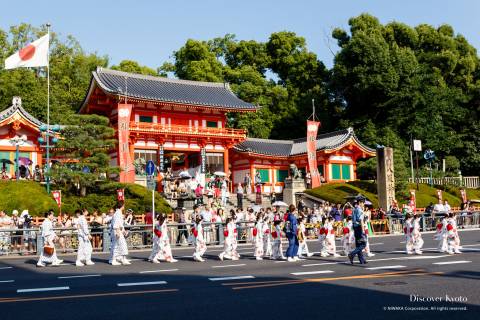
July 10th: Omukae Chōchin (Lantern Reception)
At 16:30 men carrying lanterns accompany women and young children in elaborate costumes from Yasaka Shrine along Shijō Street to Kawaramachi Street, where they will later serve as a welcome to the portable shrines when they arrive at the temporary shrine site. They make a stop in front of Kyoto City Hall to perform dance and music, and later in the evening return to Yasaka Shrine and perform again, with groups of young girls performing the Sagi Odori (Heron Dance), Komachi Odori (Young Ladies' Dance), and Gion Matsuri Ondo.
July 10th: Mikoshi Purification
From 19:00 the gods of Yasaka Shrine are transported from the main hall to a temporary shrine (otabisho) on the south side of Shijō Street. A large crowd of neighborhood men carry the three large and one small mikoshi across the Kamogawa River, where priests purify them in river water before they continue to their destination.
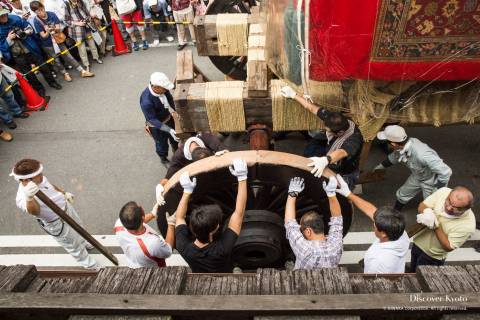
July 10th–14th: Hoko-tate, Yama-tate (Float Construction)
In each of the neighborhoods participating, the 10th through the 14th of July is a time for construction, putting together the large yama and hoko floats that will later be used in the processions. There used to be 66 floats, one for each area of Japan when the festival was established, but now 32 are built, one for each prefecture. On the 12th and 13th there will be trial runs for the floats when people will practice pulling them.
July 13th: Sacred Child Shrine Visit
On the 13th the chigo, the “sacred child” chosen each year from among Kyoto’s most prestigious families, visits Yasaka Shrine to pray for the success of the event.
There are actually multiple chigo, but by far the most famous is the Naginataboko float chigo who performs the sacred rope cutting during the main procession. Because the chigo is a vessel for the gods during this period, he is carried most everywhere so as not to touch the ground.

July 14th–16th and July 21st–23rd
Yoiyoiyoiyama, Yoiyoiyama, and Yoiyama
For three nights before the main parades, Kyoto citizens and visitors turn out in droves and flock to the Shijō-Karasuma area to celebrate. These nights are called Yoiyama. Food stalls line the streets and offer everything from shaved ice to piping hot fried noodles as the sound of Gion festival music echoes from all directions.
During this Yoiyama period the floats are lit up and on display for the city to enjoy. Everyday citizens and tourists can enter the float headquarters where relics are displayed like miniature museum exhibitions, purchase lucky charms, and sometimes climb inside the floats to have a look around for themselves. For the 15th and 16th traffic will be rerouted to make the area a pedestrian zone.
July 14th–16th: Byōbu Matsuri (Folding Screen Festival)
During this three day period in the festival, some wealthy and influential families in the Shinmachi and Muromachi areas open their doors to the public to view the treasures, particularly folding screens and artwork, that their households have accumulated over the years.
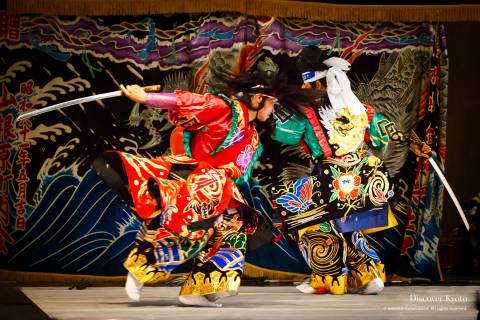
July 16th: Iwami Kagura
On the Yasaka Shrine nō stage this series of sacred dances is performed from 18:30 by a group from Izumo, where the Iwami Kagura dance tradition was born. Several short classic performances are included with elaborate costuming and masks, including the story of Shoki the demon queller, a fight between heavenly gods, and the defeat of the serpent Orochi by the god Susano’o.

July 17th: First Float Procession (Yamaboko Junkō)
The climax of the festivities, the procession begins from 9:00 and continues on along a 3-km route until about 13:00. At Fuyachō Street the sacred chigo child on the Naginata-hoko float cuts a sacred rope, ceremonially beginning the procession. Of the 9 hoko (12,000 kg, 25 m tall) and 23 yama (1,200 – 1,600 kg, ~6 m tall), two thirds participate in this parade. In order to prevent fights between neighborhoods regarding the order of the floats, positions are drawn by lottery.
The course starts from Shijō Station, turns north at Kyoto Kawaramachi Station, turns west at Kyoto City Hall, and finishes just past Karasuma Oike, making three large public turns called tsujimawashi, which are spectacles unto themselves. Combining the sight of the colorful art-draped floats and traditional costumes with the sounds of festival music and creaking wooden wheels makes for a parade akin to a moving museum!
July 24th: Second Float Procession (Yamaboko Junkō)
The remaining third of the floats participate in the latter parade. The course starts from Karasuma Oike station and retraces the former parade’s course backwards until the floats reach Shijō.

July 17th and 24th: Mikoshi Procession
During the days when the float processions are held, the portable shrines are taken from their temporary position (otabisho) on Shijō Street to make the rounds of the participating neighborhoods in the evening, carried on the shoulders of local men. On the day of the first parade the omikoshi are brought out to the otabisho, and the day of the last parade they are eventually brought home to Yasaka Shrine.

July 24th: Hanagasa Junkō (Flower Umbrella Procession)
From 10:00, ten colorful umbrella floats set out from Yasaka Shrine accompanied by around 1,000 people, mostly women, including geiko and maiko. Along the route, which crosses the Kamogawa river and makes a loop past Kyoto City Hall, various dances are performed, culminating in a final series of dance performances done as offerings to the gods at Yasaka Shrine.
July 30th: Purification at Eki Shrine
Closing out the month-long festivities is a summer purification ritual conducted at the Eki sub-shrine on Yasaka Shrine grounds. Members involved in the Gion Matsuri’s organization and floats gather to receive blessings from the priest and pass through the sacred reed ring. After all the VIPs have gone, the public is able to pass through as well.
Things to See/Do

Food Stalls

Kagura Dance

Iwami Kagura

Geisha Performance

Shinto Ritual

Period Costume

Taiko Drums

Parade

Charm
Map
Omukae Chochin on July 10th

Yamaboko Junko on July 17th

Yamaboko & Hanagasa on July 24th

Omikoshi on July 17th

Omikoshi on July 24th

Gallery
-

Omukae Chōchin

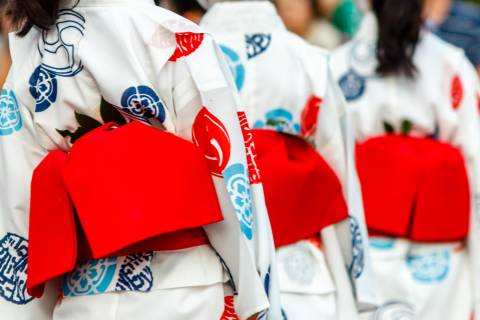
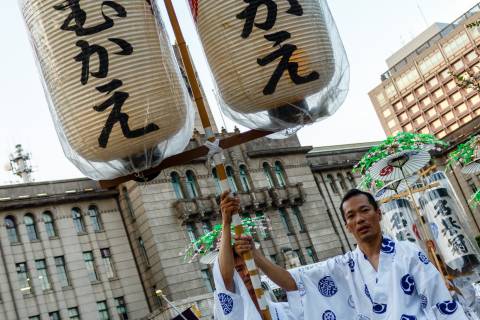
 +5
+5
-

Float Construction



 +11
+11
-
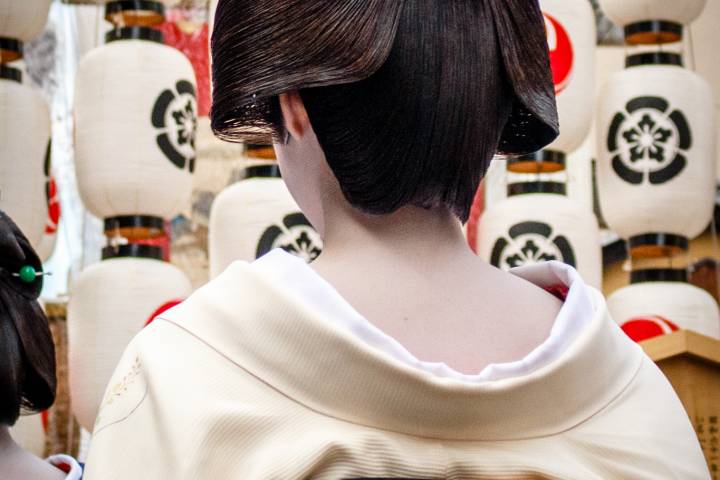
Yoiyama
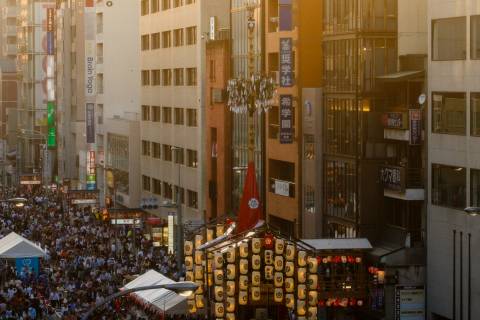


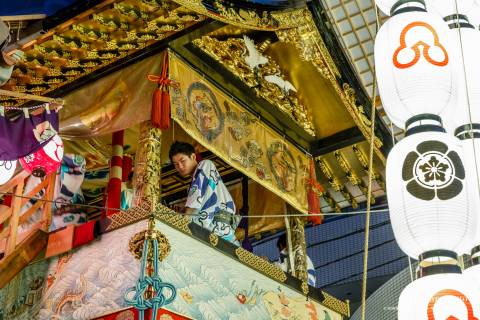 +10
+10
-

Iwami Kagura


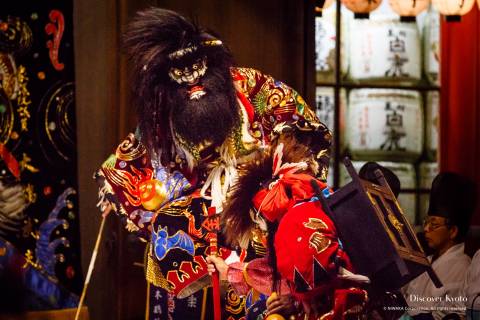
 +3
+3
-

Float Procession

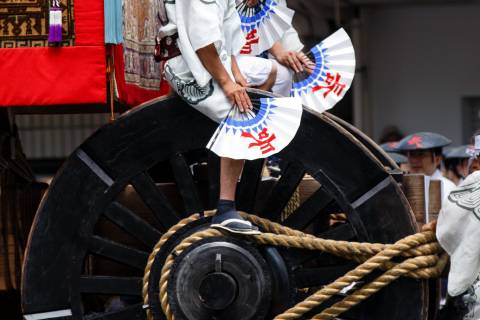

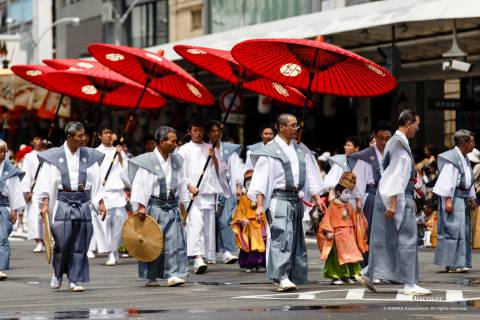 +8
+8
-

Mikoshi Procession



-

Hanagasa Junkō

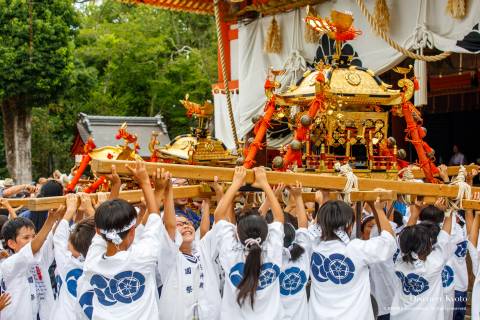
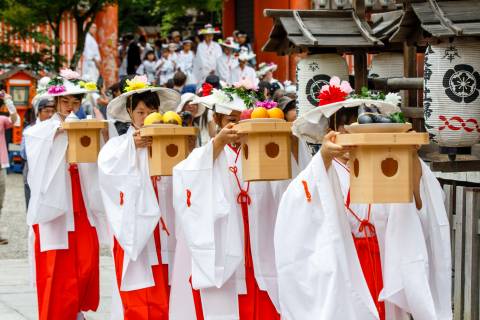
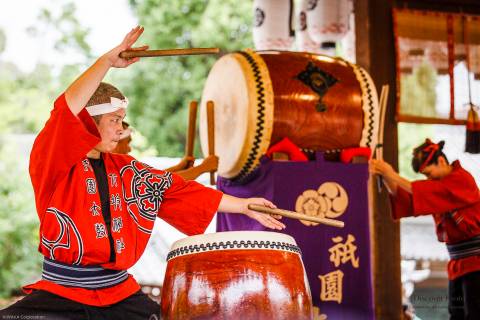 +18
+18
Access
Yasaka Jinja
Address
〒605-0073 京都府京都市東山区祇園町北側625
| TEL | 075-561-6155 |
| FAX | 075-531-1126 |
| WEB | http://www.yasaka-jinja.or.jp/en/ |
Admission
- General Admission: Free
Hours
- General Admission: 9:00 – 17:00 (grounds open to pass through 24 hours)
- Closed: No closing days
Transportation
- By Keihan Train Line ⇒ Gion Shijō Station ⇒ 5 minutes walking
- By Hankyū Train Line ⇒ Kyoto Kawaramachi Station ⇒ 8 minutes walking
- By City Bus Route 206, 100 ⇒ Gion Bus Stop
